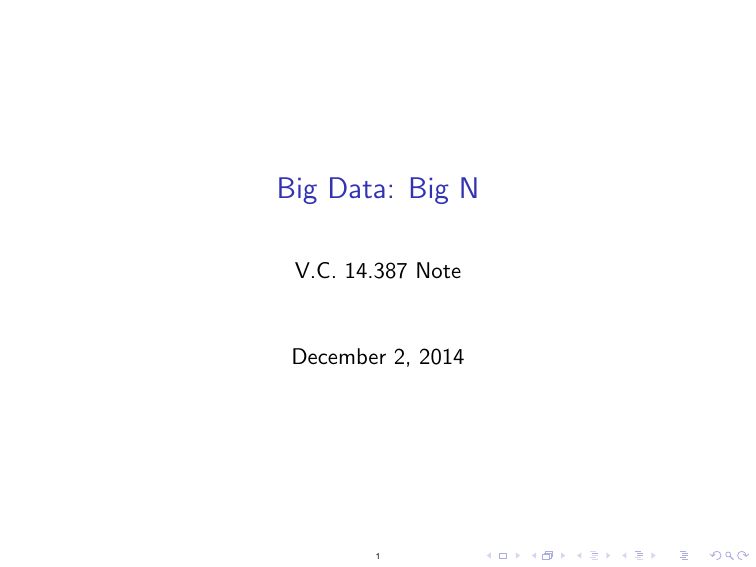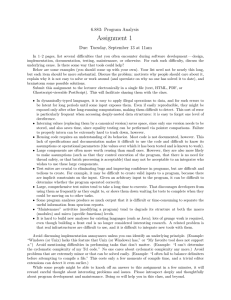Document 13404176
advertisement

Big Data: Big N
V.C. 14.387 Note
December 2, 2014
1
Examples of Very Big Data
�
Congressional record text, in 100 GBs
�
Nielsen’s scanner data, 5TBs
�
Medicare claims data are in 100 TBs
�
Facebook 200,000 TBs
�
See ”Nuts and Bolts of Big Data”, NBER lecture, by
Gentzkow and Shapiro. The non-econometric portion of our
slides draws on theirs.
2
Map Reduce & Hadoop
The basic idea is that you need to divide work among the cluster
of computers since you can’t store and analyze the data on a single
computer.
Simple but powerful algorithm framework. Released by Google
around 2004; Hadoop is an open-source version.
Map-Reduce algorithm has the following steps:
1. Map: processes ”chunks” of data to produce ”summaries”
2. Reduce: combines ”summaries” from different chunks to
produce a single output file
3
Examples
I�
Count words in docs i. Map: i → set of (word, count) pairs,
Ci Reduce: Collapse {Ci } by summing over count within
word.
I�
Hospital i. Map: i → records Hi for patients who are 65+.
Reduce: Append elements of {Hi }.
4
Map-Reduce Functionality
I
Partitions data across machines
I
Schedules execution across nodes
I
Manages communication across machines
I
Handles errors, machine failure
5
User
Program
(1) fork
(1) fork
(1) fork
Master
(2)
assign
map
(2)
assign
reduce
worker
split 0
split 1
split 2
split 3
(3) read
(5) remote read
worker
worker
(4) local write
(6) write
output
file 0
worker
output
file 1
Reduce
phase
Output
files
split 4
worker
Input
files
Map
phase
Intermediate files
(on local disks)
Figure 1: Execution overview
large clusters of commodity PCs connected together with
Index: Ghemawat.
The map functionUsed
parses each
docuCourtesy of Jeffrey Dean Inverted
and Sanjay
with
permission.
switched Ethernet [4]. In our environment:
ment, and emits a sequence of hword, document IDi
pairs. The reduce function accepts all pairs for a given 6 (1) Machines are typically dual-processor x86 processors
Amazon Web Services
I
Data centers owned and run by Amazon. You can rent
”virtual computers” minute-by-minute basis
�
I
more than 80% of the cloud computing market
�
I
nearly 3,000 employees
�
I
cost per machine: 0.01 to 4.00 /hour
�
I
Several services in AWS
�
I
S3 (Storage)
�
I
EC2 (Individual Machines)
�
I
Elastic Map Reduce
�
I
distribute the data for Hadoop clusters
7
Distributed and Recursive Computing of Estimators
We want to compute the least squares estimator
βˆ ∈ arg min n−1
b
n
n
(yi − xif b)2 .
i=1
The sample size n is very large and can’t load the data into a
single machine. What could we do if we have a single machine or
many machines?
Use the classical sufficiency ideas to distribute jobs across
machines, spatially or in time.
8
The OLS Example
�I
We know that
β̂ = (X f X )−1 (X f Y ).
�I
Hence we can do everything we want with just:
X fX ,
X fY ,
n,
S0 ,
where S0 is a ”small” random sample (Yi , Xi )i∈I0 with sample
size n0 , where n0 is large, but small enough that the data can
be loaded in the machine.
I
�
We need X f X and X f Y to compute the estimators to
compute the estimator.
I
�
We need S0 to compute robust standard errors and we need
to know n to scale these standard errors appropriately.
9
The OLS Example Continued
I
The terms like X f X and X f Y are sums that can be computed
by distribution of jobs over many machines:
1. Suppose machine j stores sample Sj = (Xi , Yi )i∈Ij of size nj .
2. Then we can map Sj to the sufficient statistics
Tj =
n
Xi Xif ,
n
Xi Yi , nj
i∈Ij
i∈Ij
for each j.
3. We then collect (Tj )M
j=1 and reduce them further to
T =
M
n
Tj = (X f X , X f Y , n).
j=1
10
The LASSO Example
The Lasso estimator minimizes
(Y − X β)f (Y − X β) + λIΨβI1 ,
Ψ = diag(X f X )
or equivalently
Y f Y − 2β f X f Y + β f X f X β + λIΨβI1 .
Hence in order to compute Lasso and estimate noise level to tune
λ we only need to know
Y fX ,
X fX ,
n,
S0 .
Computation of sums could be distributed across machines.
11
The Two Stage Least Squares
The estimator takes the form
(X f PZ X )−1 X f PZ Y = (X f Z (Z f Z )−1 Z f X )−1 X f Z (Z f Z )−1 Z f Y .
Thus we only need to know
Z fZ ,
X fZ ,
Z fY ,
n,
S0 .
Computation of sums could be distributed across machines.
12
Digression: Ideas of Sufficiency are Extremely Useful in
Other Contexts
Motivated by J. Angrist, Lifetime earnings and the Vietnam
era draft lottery: evidence from social security administrative
records, AER, 1990.
�
I We have a small sample S0 = (Zi , Yi )i∈I0 , where Zi are
instruments (that also include exogenous covariates) and Yi
are earnings. In ML speak, this is called ”labelled data” (they
call Yi labels, how uncool)
�I We also have huge (n » n0 ) samples of unlabeled data (no Yi
recorded) from which we can obtain Z f X , X f X , Z f Z via
distributed computing (if needed).
I We can compute the final 2SLS-like estimator as
�
�
I
n
0
n
n
· (X f Z (Z f Z )−1 Z f X )−1 X f Z (Z f Z )−1
Zi Yi
n0
i=1
Can compute standard errors using S0 .
13
Exponential Families and Non-Linear Examples
Consider estimation using MLE based upon exponential families.
Here assume data Wi ∼ fθ , where
fθ (w ) = exp(T (w )f θ + ϕ(θ)).
Then the MLE maximizes
n
n
i=1
logfθ (Wi ) =
n
n
T (Wi )f θ + ϕ(θ) =: T f θ + nϕ(θ).
i=1
The sufficient statistic T can be obtained via distributed
computing. We also need an S0 to obtain standard errors.
Going beyond such quasi-linear examples could be difficult, but
possible.
14
M- and GMM - Estimation
The ideas could be pushed forward using 1-step or approximate
minimization principles. Here is a very crude form of one possible
approach.
Suppose that θ̂ minimizes
n
n
m(Wi , θ).
i=1
Then given an initial estimator θ̂0 computed on S0 we could do
Newton iterations to approximate θ̂:
n
−1 n
n
n
2
θ̂j+1 = θ̂j −
Vθ m(Wi , θ̂j )
Vθ m(Wi , θ̂j ).
i=1
i=1
Each iteration involves sufficient statistics
n
n
n
n
2
ˆ
Vθ m(Wi , θˆj )
Vθ m(Wi , θj ),
i=1
i=1
which can obtained via distributed computing.
15
Conclusions
�I
We discussed the large p case, which is difficult. Approximate
sparsity was used as a generalization of the usual parsimonius
approach used in empirical work.
I
A sea of opportunities for exciting empirical and theoretical
work.
I
We discussed the large n case, which is less difficult. Here the
key is the distributed computing. Also big n samples often
come in ”unlabeled” form, so you need to be creative in order
to make good use of them.
�I
This is an ocean of opportunities.
16
MIT OpenCourseWare
http://ocw.mit.edu
14.387 Applied Econometrics: Mostly Harmless Big Data
Fall 2014
For information about citing these materials or our Terms of Use, visit: http://ocw.mit.edu/terms.







